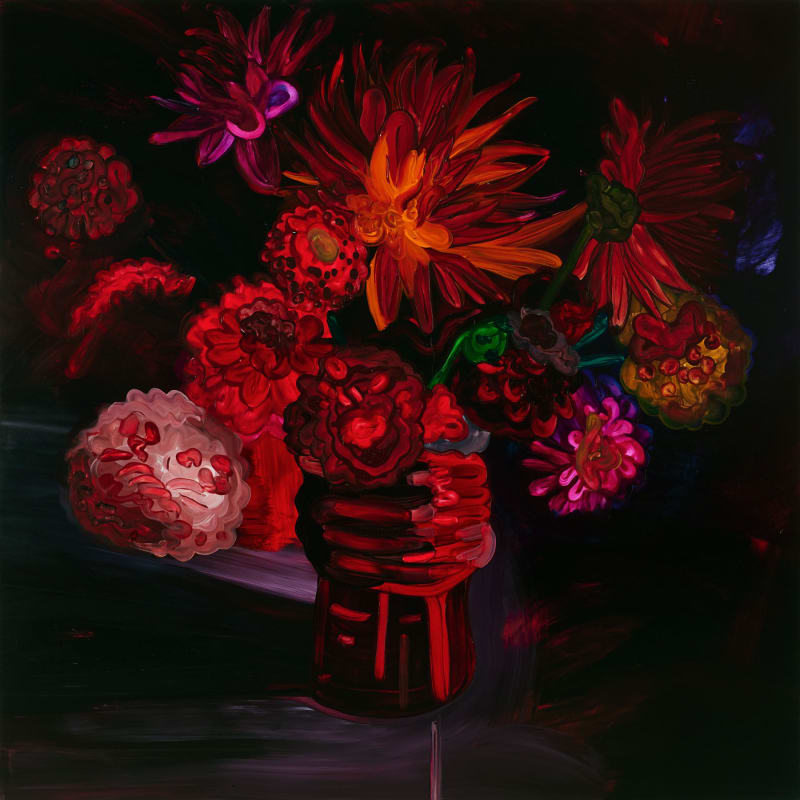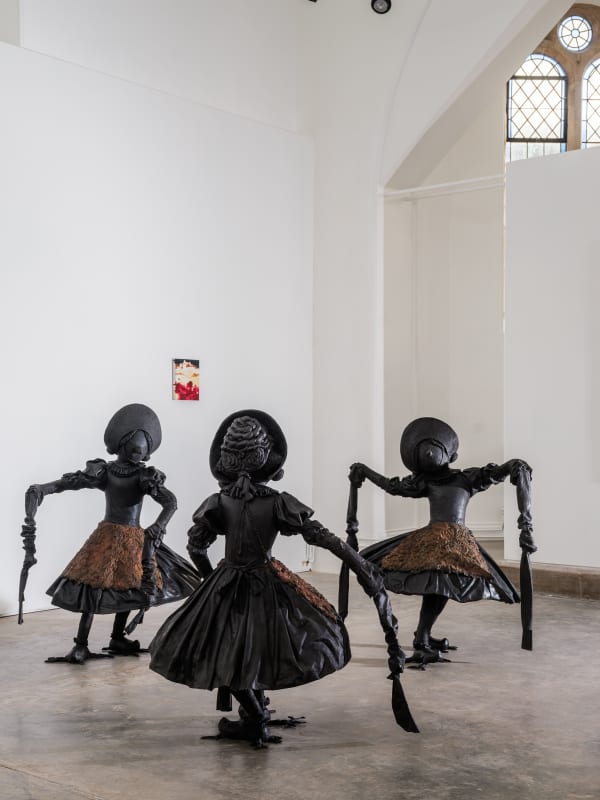The Guts and The Glory
Past exhibition
Overview
The Guts and The Glory brings together the works of six painters and sculptors. The artists each utilise visual language borrowed from art history to offer a contemporary perspective that remains relevant to concerns of today. Often with an expressive handling of the material, a raw and personal angle is achieved. From Rococo battle scenes to Neoclassical sculpture, the fragility of the body and natural world are contrasted with the heroic, tragic or morbid, and we are invited to see how the motifs fare a contemporary reckoning.
Samuel Bassett’s paintings present the rituals of everyday life that tie us to a place’s history. Born in St. Ives and now based in Penwith, Cornwall, Bassett draws on his surroundings for inspiration, referencing the local landscape, lifestyle and people along with his own inner explorations. With a melancholic sense of humour and an intuitive use of the medium, his paintings are visceral, layered and expressive. In the teals, blues and dark greys that make up the distinctive palette of the Cornish coastline, Bassett portrays a place that has been much romanticised with a more real and personal account of how he knows it to be.
Kim Booker uses colour, gesture and figure to express the psychology of the female experience. Her semi-autobiographical paintings often feature figures in poses that are suggestive of differingemotional states, created intuitively through a combination of gestural abstraction and layers of drawn imagery. Elements are scrubbed out, obscured, and over-painted, with dynamic strokes and crawls of colour reflecting both the physicality of painting and the emotions of the painter: self-censorship in real-time. Rooted in the tradition of modern painting, Booker’s work shows the influence of German Expressionism, idiosyncratic British painting and American abstract expressionism - combined with a contemporary perspective on identity and relationships.
Tomo Campbell’s large oil paintings depict busy, layered scenes of activity in which multiple
perspectives and focal points keep the eye constantly in motion. Inspired by Victorian etchings,
Athenian vases and medieval tapestries, his paintings often depict a sea of Neoclassical figures and regal horses marching, parading or going to battle in triumphant spirits, fragmented across the canvas as if to fill it with every nuanced moment. Campbell’s fluid brushstrokes bring a vibrancy and rapid motion effect to his works, painted in an unnatural palette, forming highly abstracted impressions far removed from their original contexts.
Laura Ford’s life-size bronze sculptures contain both a sense of the fantastical and the nightmarish, depicting children trying on different costumes and identities, or experiencing difficult emotional states. In ‘Dancing Clog Girls’, Ford refers to a historic royal visit made by Marie Antoinette to a baroque palace in 1770, at which local people were presented. With feature-less, puppet-like faces, roots growing out of their clogs and furry aprons that suggest an animal nature, the Clog Girls, are still unable to achieve the fantasy of elevation, despite their twirling postures. Here, Ford sets about unpicking the illusions of refinement that are still so appealing to children when they play Kings and Queens.
Alexis Soul-Gray’s practice explores idealised depictions of family life and the mother-child bondfound in 20th century media and advertisements. Working with found imagery from a wide range of sources - from knitwear catalogues to biscuit tins - she manipulates the imagery before transforming it into drawings, prints and paintings. On a journey of bereavement, Soul-Gray replaces her lost memories with found images, reworking and restaging them to imagine a different narrative.
Informed by her background in sculpture, Clare Woods’ oil paintings on aluminium depict still life scenes and other classical art subjects with a visceral and bodily quality. The three-dimensionality of her process allows Woods to contort foreground and background, creating a surreal effect. In broad, fluid brushstrokes, familiar scenes are portrayed as if without their outer shell, revealing the vulnerable, transient nature beneath the surface, evocative of human fragility.
Referencing a range of art historic movements and subjects, the exhibition positions these familiar aesthetics as a vehicle for the artists to give their personal account or philosophy, freed from the values of these eras, or at times a playful critique of them.
Works
 Tomo Campbell, And You, 2023
Tomo Campbell, And You, 2023 Tomo Campbell, So Says You , 2023
Tomo Campbell, So Says You , 2023 Clare Woods, Treat Lightly , 2023
Clare Woods, Treat Lightly , 2023 Kim Booker, Complicated Muse, 2023
Kim Booker, Complicated Muse, 2023 Laura Ford, My Little Marini (Bronze), 2020
Laura Ford, My Little Marini (Bronze), 2020 Laura Ford, Dancing Clog Girls (set of 3) , 2015
Laura Ford, Dancing Clog Girls (set of 3) , 2015 Samuel Bassett, Man Upstairs, 2023
Samuel Bassett, Man Upstairs, 2023 Samuel Bassett, Through The Cliffs and into the Sea, 2023
Samuel Bassett, Through The Cliffs and into the Sea, 2023 Alexis Soul-Gray, Moth Girl, 2023
Alexis Soul-Gray, Moth Girl, 2023 Alexis Soul-Gray, Try to listen to what I tell you, 2023
Alexis Soul-Gray, Try to listen to what I tell you, 2023
Installation Views























